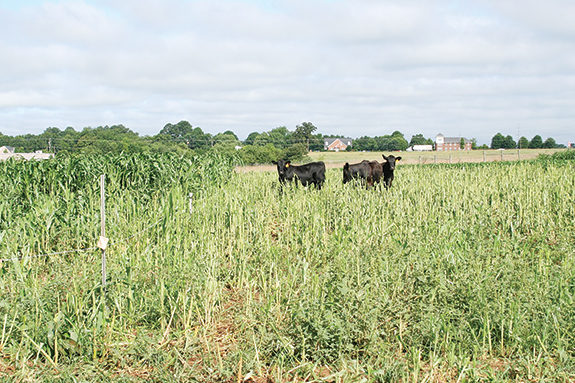Unlike animals that can run and hide from predators, plants must stay and fight. To ward off animals or pests that might try to attack, plants have all sorts of defense mechanisms.
Many of the defense mechanisms are types of chemical warfare. These plant species generate poison-containing compounds that prevent herbivores from eating them – or at least make the animal regret it if they did.
Grazing animals encounter a number of these compounds on a regular basis. In most cases, these compounds are in such low concentrations that they are not problematic. Occasionally, though, these poisonous compounds can reach such a critical level that they cause a substantive problem.

Cyanide-containing plants
There are several forage crops and plants that may be found in pastures that naturally produce compounds that are cyanogenic or precursors to cyanide (sometimes called prussic acid).
Cases of prussic acid poisoning in livestock are commonly linked to members of the sorghum family (e.g., forage sorghum, sudangrass, Johnsongrass, etc.) and the consumption of leaves associated with certain trees in or near the pasture (e.g., black cherry, chokecherry, etc.).
However, there are over 2,000 species known to have the potential to produce cyanide.
Even some fruits, vegetables and nuts (e.g., almonds, peaches, apples, apricots, cherries, lima beans, cassava, etc.) produce cyanogenic compounds in some of their plant tissues (usually seeds).
The cyanide-generating compounds are typically present in plants as a cyanogenic glycoside, a compound with sugar molecules bound to cyanide-containing molecules.
Cyanogenic plants usually produce more of these compounds in response to severe drought, insect damage, nutrient deficiencies, herbicide applications (including 2, 4-D), freeze injury and other stress factors.
Cyanogenic glycosides in and of themselves are not inherently toxic, since they must come in contact with appropriate enzymes for the cyanide molecule to be released.
Cyanogenic compounds are not normally broken down in the intact plant because the glycosides and the enzymes that break them down are separated in different plant tissues.
In members of the sorghum family, for example, the cyanogenic glycoside dhurrin is present in the epidermal cells at the surface of a leaf, while the enzymes are located in the mesophyll cells in the middle of the leaf. Consequently, the cyanide is only released if the cyanogenic glycosides and enzymes come into contact.
This may happen if the cells rupture, as a result of frost damage, for instance. However, it may also happen if the leaf is cut or crushed as it is consumed. Ruminants are at the greatest risk because the rumen is more neutral in pH, and it contains a large number of microbes, which produce a number of enzymes that can hydrolyze (or break apart) the sugar and liberate the cyanide molecule.

The consequences of cyanide poisoning
Cyanide is poisonous to all animals because it rapidly shuts down respiration at the cellular level.
Oxygen may be present, but if sufficient quantities of cyanide are present, the consumption of glucose is inhibited.
Additionally, the hemoglobin becomes so oxygen-saturated that it causes the blood to be cherry red. This is why “cherry-red” blood is a common postmortem diagnostic indicator of cyanide poisoning.
Cyanogenic plants commonly have some small concentration of cyanide. At low levels, cellular enzymes and naturally formed thiosulfates can detoxify cyanide.
The resultant thiocyanate is relatively harmless and is excreted in the urine. When high concentrations of cyanide are in the diet, the body’s detoxification mechanisms are overwhelmed and cyanide poisoning occurs.
It is estimated that the lethal dose of cyanide is in the range of 2 to 2.5 mg per kg of bodyweight. However, the formation and absorption of cyanide may be slowed if plenty of other plant material and carbohydrates are present in the stomach. In addition, animals consuming high-grain diets usually have a lower pH in their rumen, and this will slow the release of the cyanide.
Clinical signs of cyanide poisoning
Signs of cyanide poisoning include rapid and difficult breathing, frothing at the mouth, dilated pupils, involuntary movements, muscle tremors, convulsions and ultimately death.
Unfortunately, cyanide poisoning is so fast-acting that there is little time to administer a treatment. Animals that have consumed a lethal concentration of cyanide usually die quickly (less than 30 minutes) once clinical signs of poisoning have developed.
Treatment of cyanide poisoning
If cyanide poisoning is strongly suspected and (through quick action) treatment is possible, it is recommended to intravenously administer a mixture of 1 mL of 20 percent sodium nitrite and 3 mL of 20 percent sodium thiosulfate for every 100 pounds of bodyweight.
The dose may be repeated in a few minutes if the animal does not respond. Care should be taken to avoid administering too much of this treatment, or confusing cyanide poisoning for nitrate poisoning, because the addition of sodium nitrite can, in effect, induce nitrite poisoning or exacerbate nitrate toxicity.
Animals suspected of consuming cyanogenic plants, but which have not yet shown signs, can be given a prophylactic dose of sodium thiosulfate via a stomach tube. Drenching the rumen with 5 gallons of a 25 percent solution of vinegar will help acidify the rumen and reduce cyanide production.
Prevention of cyanide poisoning
Since cyanide poisoning acts too rapidly to allow for sign recognition and treatment administration, it is important to take steps that minimize the risk of cyanide poisoning.
To be safe, avoid grazing areas where known cyanide-containing forage plants are present and stress factors may have increased the concentrations of cyanogenic compounds. Also, avoid grazing such areas after a hard frost or freeze for a period of two weeks or more following a true killing frost.
The cyanide-containing compounds are volatile, and they will dissipate in time. In fact, prussic acid poisoning is rarely a problem in well-cured hay. However, it is important to recognize that a light frost that does not kill the plant may increase the concentrations of cyanogenic compounds in the plant parts that were not killed by the cold injury.
Additionally, some frost-damaged plants may put on new shoots. Immature shoots may contain higher levels of cyanogenic compounds, especially when the plant is recovering from stress.
When combined with the fact that these newest shoots are selectively grazed, grazing cyanogenic plants after a light but not killing frost may actually place livestock at greatest risk.
Feeding silage made from plants that contain cyanogenic compounds is generally safe. Though the forage may contain cyanogenic compounds when ensiled, much of the poison will dissipate during fermentation and when it is processed for feeding.
As a precaution, do not feed any silage suspected of high levels of cyanogenic compounds within three weeks of being ensiled.
Suspect forages can be tested for prussic acid concentrations. However, the volatile nature of the compounds requires the test be conducted soon after sampling or that the sample is frozen immediately after sampling. FG
PHOTOS
Johnsongrass following a selective herbicide control may have cyanide-generating concentrations that would be poisonous to grazing livestock. Photos courtesy of Dennis Hancock.












